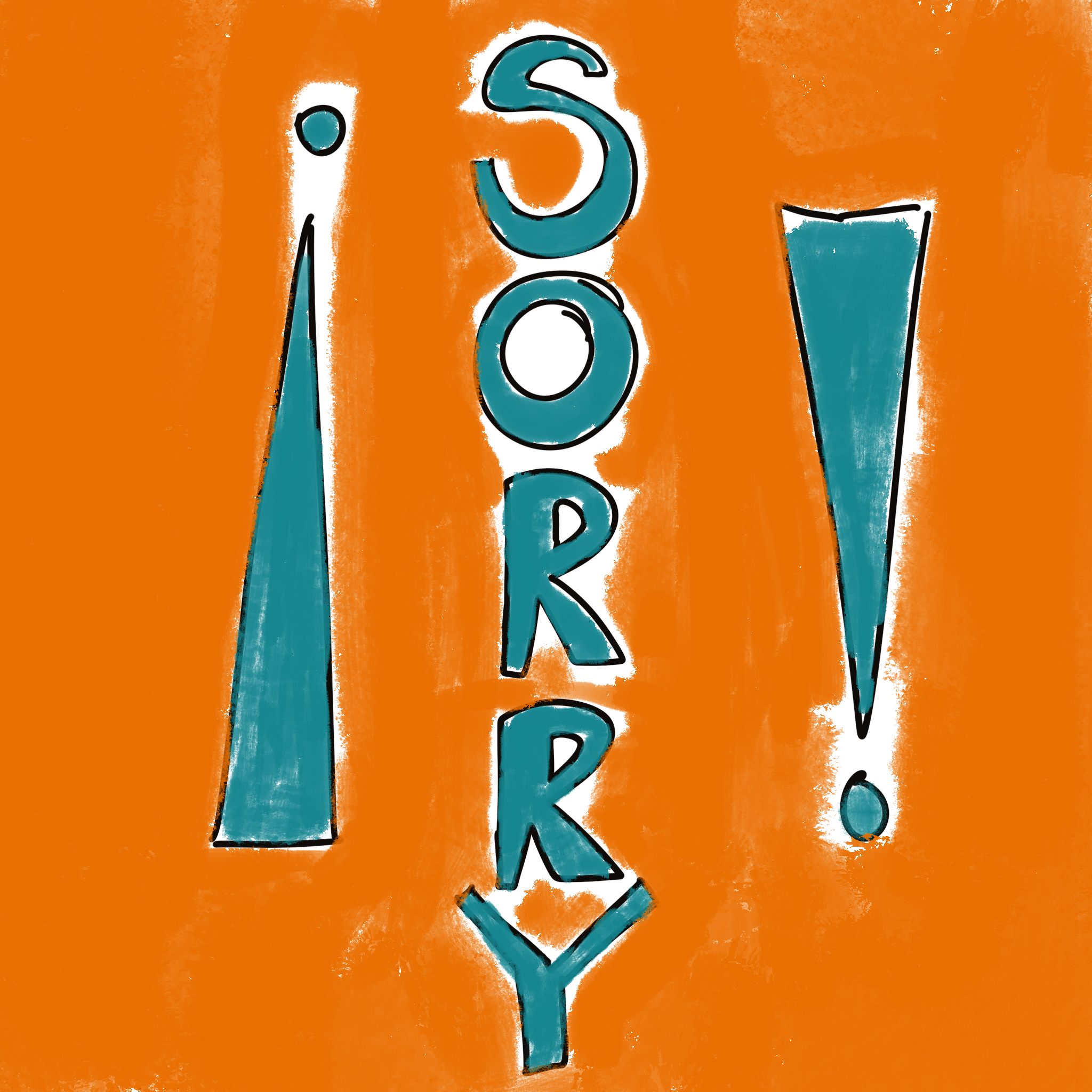The power of the sincere apology is in the mindset we have when we make it.
Mistakes happen. We’re human. It’s in our DNA. As hard as we try, there are going to be times we fall flat on our face.
And when that happens the question is – how will we deal with it?
Apologies don’t come easy.
Twice this past month, we saw Israeli CEOs botch up.
Instead of thinking up ways to use the crisis as an opportunity to rebuild trust, they chose to undermine their credibility, and the reputation of the organizations they represent.
In an interview to Globes, Shufersal’s CEO, Ori Watermann, justified its position:
“But we are in the middle of a haredi neighborhood, Shufersal provides services to all the people of Israel, and I as a human being first of all, respect my customers regardless of who they are.”
(Read about the fiasco and How Business Values Can Help Find Gender Erasure here.)
In a second unrelated event, the CEO of Hayuta, a pet insurance brand, offended thousands of customers denying any wrongdoing and dismissing it as “not properly understood.”
I learned about this through a LinkedIn post:
The result of course is customers feeling alienated, resentful and distrustful, which leads to negative word-of-mouth and loss of loyalty.
I tend to think that both men would have been better served had they simply apologized without justifying themselves, or deflecting responsibility by blaming their customers for misunderstanding.
But apologies aren’t simple. They are a tangled web of complexity and importance.
Why apologies are important
Apologies restore dignity, integrity and trust that have been lost.
They are a sign of humility and consideration, and they symbolize that we are human, that we make mistakes, and that we know to take responsibility for our errors.
Apologies provide the offender with the opportunity to validate the emotions of those they have harmed, and they enable the target of the bad behaviour to feel heard and understood. When we are heard, we feel valued, accepted and important. This is vital for our psychological wellbeing, self-worth, and for promoting trust and cooperation.
As cheesy as it sounds, apologies also provide us with the opportunity to learn and grow. Through learning from past behaviours, taking corrective action, and implementing preventative measures, we can help avoid similar occurrences from happening in the future.
In the ever-evolving landscape of brand reputation, a sincerely crafted apology can serve as a beacon of hope, and bridge the chasm of trust.
But if so –
Why are we reluctant to apologize?
In order to gain some insight on the subject, I reached out to Olga Kitaina, co-founder of Alter, a TED fellow, and a psychologist specializing in positive psychology with a Master of Applied Positive Psychology from the University of Pennsylvania (UPenn).
She shares that in the realm of leadership, “Leaders may fear that an apology could tarnish their reputation or be construed as an admission of guilt. This fear can be exacerbated by the potential for legal implications or backlash from stakeholders.” In high-profile roles, where the spotlight burns brightest, the haunting shadow of reputational damage lurks, making it difficult to embrace the simple act of saying “I’m sorry.”
According to Kitaina, the intricacies of offering an apology deepen as we navigate their complexity. Stepping forward to express remorse can trigger personal unease and professional hazards. Leaders grapple with the profound implication that merely acknowledging a misstep or wrong doing can have profound repercussions. Kitaina aptly observes, “Leaders may worry that an apology could result in a loss of power, authority, or credibility.”
In addition, a leader’s resistance to apologize is deeply intertwined with their personal and cultural beliefs. Some mistakenly view apologizing as a sign of weakness, vulnerability, or even incompetence, inevitably eroding their authority and leadership. “Leaders with strong egos or a belief in their infallibility may find it especially difficult to apologize. They may have a personal reluctance to admit mistakes or may perceive apologizing as a personal failure,” Kitaina says.
Organizational culture is another important factor that significantly impacts a leader’s readiness to apologize. As Kitaina points out, “The culture within an organization can also influence a leader’s reluctance to apologize. In some environments, there may be a lack of emphasis on accountability or a belief that apologizing is unnecessary or counterproductive.” In these settings, the relentless drive for progress, and the desire to hold onto power overshadow the true value of remorse, further deepening their hesitation.
Yet, Kitaina notes, “It’s crucial to note that these factors can vary depending on the individual leader and the specific context. Not all leaders exhibit the same reluctance to apologize, and some may recognize the importance and benefits of offering a sincere apology.”
The 7 Key Elements of a Sincere Apology
Kitaina identifies seven key elements in a sincere apology:
-
Acknowledging the Offense
A sincere apology begins with a clear recognition of the specific actions that caused harm or offense. By acknowledging these actions, we validate the feelings and experiences of those we have hurt, showing them that their pain is acknowledged and respected.
-
Accepting Responsibility
When apologizing, it’s crucial that we fully accept responsibility for our actions. This means refraining from making excuses or shifting the blame to others. When we take ownership for our mistakes, we demonstrate accountability and a willingness to face the consequences of our behaviour.
-
Expressing Genuine Remorse
Through expressing both regret for the harm caused and an emotional understanding of the distress experienced by others, we can convey genuine remorse. This empathy demonstrates that we recognize that our actions have impact, and that we genuinely care about the wellbeing of those we affected.
-
Demonstrating Empathy and Understanding
In addition to the above, actively listening to emotions, acknowledging pain, and showing a genuine willingness to understand the perspective of those we have hurt, creates space for healing and open communication.
-
Explaining What Went Wrong
Not always, but sometimes, an explanation is appropriate. This could be in complex circumstances that require an understanding of context, or situations where the harm caused was unintentional or misinterpreted. However, before providing an explanation, it’s crucial to ensure that explanations don’t serve as excuses, shift blame, minimize responsibility, or justify and defend wrongful behaviour.
-
Committing to Change
A sincere apology includes a commitment to making amends and preventing a recurrence of the offense. Such a commitment goes beyond mere words and involves ongoing self-reflection and improvement. By working towards change, we demonstrate our dedication to learning from our mistakes and actively working towards becoming a better person.
-
Following Through
The full meaning of an apology will be realized when it is backed by action that align with the commitments made. Following through on our promises shows integrity and consistency. This reinforces the sincerity of our words, and over time, helps rebuild trust
The X Factors of Apologies
In addition to these key elements, Kitaina points out several factors that can enhance the sincerity and effectiveness of an apology:
- Timing – apologize promptly after the offense, or as soon as you become aware of it.
- Tone – the tone of your apology should be respectful, humble and sincere.
- Nonverbal cues – maintain eye contact, display genuine facial expressions, and use open body language to convey sincerity and remorse.
- Be specific – tailor your apology to the specific situation and individuals involved, acknowledging their unique experiences and concerns
- Be a good listener – actively listening to the perspectives and emotions of the aggrieved party is crucial
- Avoid conditional language – do not include conditional statements or qualifiers, as this will diminish the sincerity of your apology
- Be open to feedback – be open to feedback and even criticism. This will foster accountability and rebuild trust
- Be discreet – assess the situation, sometimes it is best to keep the apology discreet
- Be sensitive to culture differences – your apology should be respectful of the cultural nuances and sensitivities of the aggrieved party
Apologies can make us or break us. If we use apologies as opportunities for growth and learning instead of seeing them as failures we should hide, we stand a much better chance of doing what’s right – for ourselves, for others, and for the brand we represent.
Want great insights about business, marketing, and more?
Sign up for my weekly newsletter here.

